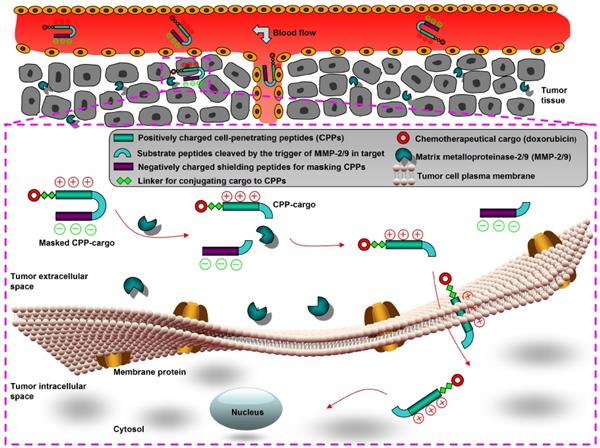Cell-penetrating peptide (CPP), also called "Trojan Horse" peptide, has become a successful approach to deliver various payloads into cells for achieving the intracellular access. However, the "Trojan Horse" peptide is too wild, not just to "Troy", but rather widely distributed in the body. Thus, there is an urgent need to tame the wildness of "Trojan Horse" peptide for targeted delivery of antineoplastic agents to the tumor site. To achieve this goal, we exploit a masked CPP-doxorubicin conjugate platform for targeted delivery of chemotherapeutic drugs using charge-guided masking and protease-triggered demasking strategies. In this platform, the cell-penetrating function of the positively CPP (d-form nonaarginine) is abrogated by a negatively shielding peptide (masked CPP), and between them is a cleavable substrate peptide by the protease (MMP-2/9). Protease-triggered demasking would occur when the masked CPP reached the MMP-2/9-riched tumor. The CPP-doxorubicin conjugate (CPP-Dox) and the masked CPP-Dox conjugate (mCPP-Dox) were used as models for the evaluation of masking and demasking processes. It was found that exogenous MMP-2/9 could effectively trigger the reversion of CPP-cargo in this conjugate, and this trigger adhered to the Michaelis-Menten kinetics profile. This conjugate was sensitive to the trigger of endogenous MMP-2/9 and could induce enhanced cytotoxicity toward MMP-2/9-rich tumor cells. In vivo antitumor efficacy revealed that this masked conjugate had considerable antitumor activity and could inhibit the tumor growth at a higher level relative to CPP-cargo. Low toxicity in vivo showed the noticeably decreased wildness of this conjugate toward normal tissues and more controllable entry of antitumor agents into "Troy". On the basis of analyses in vitro and in vivo, this mCPP-cargo conjugate delivery system held an improved selectivity toward MMP-2/9-rich tumors and would be a promising strategy for tumor-targeted treatment.
